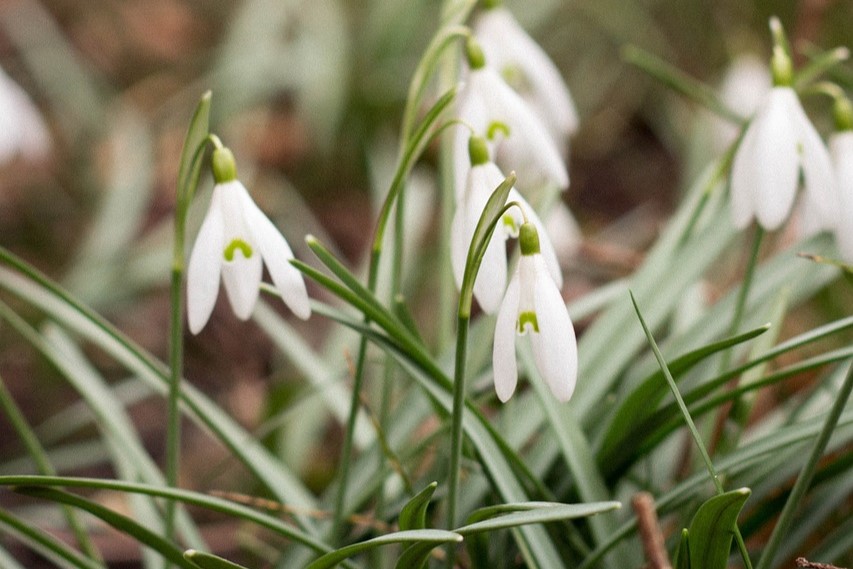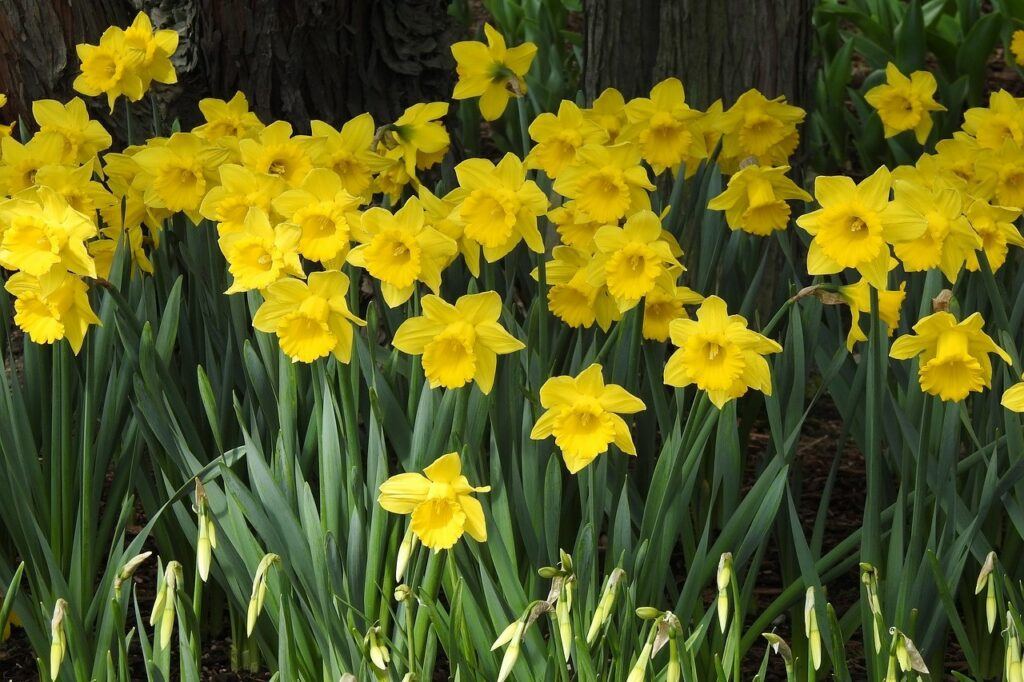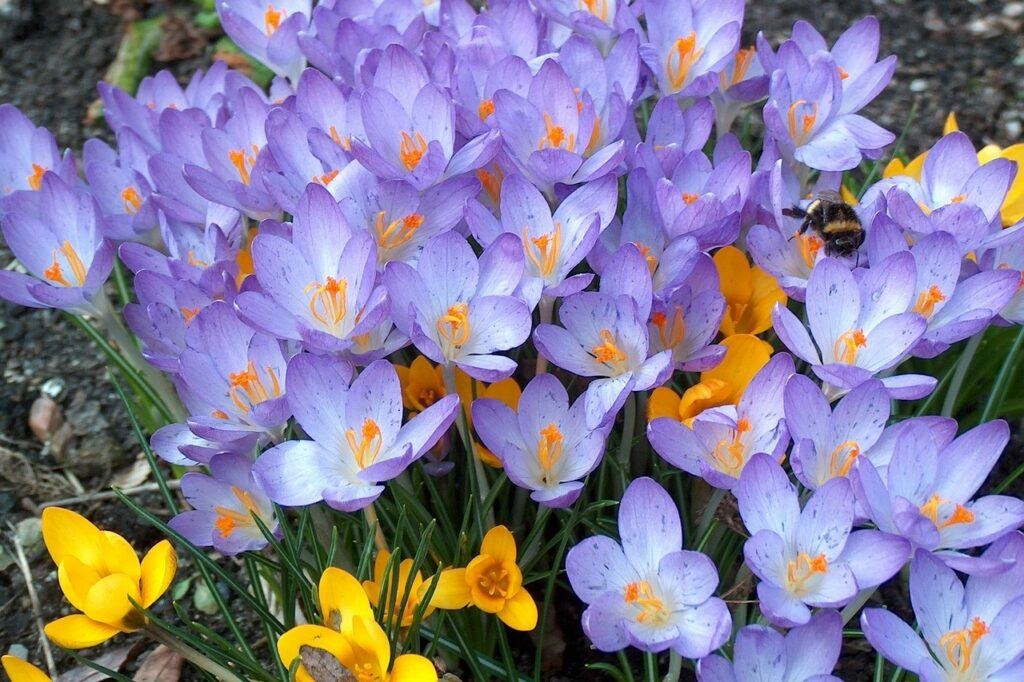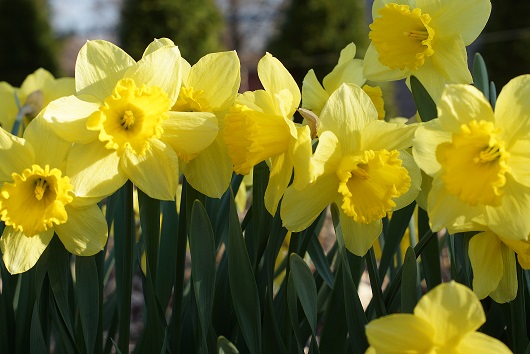Plant These Bulbs In The Fall For Spring Flowers
If you want early spring flowers, plant these bulbs in the fall. Bulbs to plant in autumn include tulips, hyacinth, crocus, daffodils, snowdrops, alliums, snowflakes and winter aconite. Bulbs planted in fall provide early spring flowers long before other plants have even broken the soil.
Spring flowering bulbs need time to chill in the ground in order to bloom in the springtime. The best time to plant is late Autumn. If you plant them too early, they may start to grow again and will not bloom at the correct time in spring, or they might rot in the ground before cool temperatures arrive.
Use flowering bulbs in your garden to start spring with a burst of colorful energy. In rock gardens, dwarf bulb varieties tucked into crevices soften hard edges of stones or other hardscapes.

1. Snowdrops (Galanthus)
Each small bulb produces two to three flat narrow leaves and stems in midwinter through early spring. The nodding flowers have white outer petals with a set of shorter inner petals that have green tips. Plants die back to the ground by early summer.
6-12 inches tall
Full sun to partial shade
Well-drained, average to moist, fertile soil
Grow in Zones 3 to 9
Best when planted in groups in soil that will not dry out in summer. Plant Snowdrop bulbs in fall, 3-4 inches deep and 3-4 inches apart. Not considered invasive, Snowdrops form naturalized compact drifts.
Grow snowdrops with other early flowers such as Crocus or Grape Hyacinth. They naturalize well in lawns, low maintenance areas or under deciduous trees and shrubs. If grown in lawns, you’ll need to wait until the leaves have turned yellow to mow.

2. Daffodils
Clumps of flat, strap-shaped green leaves emerge in early spring along with flower stalks. Depending on the cultivar, flowers appear in early, mid or late spring. Not all flowers are scented.
Each flower has a cup or trumpet (technically known as a corona) and an outer ring of petals (known as the perianth). There are many types of daffodils available in varying colors and bulb sizes.
The leaves usually remain green until midsummer, then turn yellow and die back to the ground. Allow leaves to turn yellow before cutting them back or pulling them out. Tying them up or braiding them is not recommended. Daffodils use the leaves to gather and transport nutrition to the bulb for next years’ blooms.
14-24 inches tall
Full sun to partial shade
Well-drained, average moisture, fertile soil
Grow in Zones 3 to 8
Plant bulbs in early to mid-fall. Set them in individual holes or large planting areas dug 4–8 inches deep. Space small types 3-4 inches apart and larger types 8-10 inches apart. Daffodil bulbs multiply quickly. Allow them space to multiply so they don’t get overcrowded. Plant about 6-8 inches deep depending on bulb size.

3. Muscari (Grape Hyacinth)
Grape Hyacinth are most noted for their grass-like leaves and dense spikes of grape-like blooms that top stalks in early spring. The individual purple-blue, white-rimmed flowers are about ¼ inch wide. The leaves turn yellow and die back by early summer.
6-12 inches tall
Full sun to partial shade
Well-drained, moist, fertile soil
Grow in Zones 4 to 10
Plant Grape Hyacinth bulbs in early to mid-fall. Set in individual holes or large planting areas dug 2-3 inches deep. Space the bulbs about 3-4 inches apart. Divide after leaves have died back in summer.
Bulbs left undisturbed multiply rapidly and the plant easily self-sows, which can become invasive in some instances.
Use Grape Hyacinths as a border plant or in wildflower and rock gardens. Their intense purple-blue color makes a striking contrast with other spring flowers such as daffodils and tulips.

4. Tulips
Tulips are easily recognized by their broad, dusty-green leaves in early to mid spring. Stems are topped with single or double flowers up to 4 inches across. Many varieties have been developed to emphasize color patterns, flower shapes and petal features such as fringed edges.
Pinch off the developing seed pod after flowering, and allow the leaves to yellow before removing them. Some people treat tulips as annuals and re-plant them yearly. In this instance, there is no need to allow leaves to yellow before removing them.
6-30 inches tall
Full sun to partial shade
Well-drained, average soil
Grow in Zones 4 to 8
Plant tulip bulbs 4-6 inches deep and 3-6 inches apart. They are excellent when used for borders, rock garden and naturalizing.

5. Crocus
Crocus appear in late winter to early spring, with leaves and flowers at the same time. The grass-like leaves of crocus are thin and green with a light center stripe. Cup shaped flowers are up to 3 inches across and bloom just above the leaves. Flowers are white, lavender, purple or yellow, and may be striped with contrasting colors.
Thriving in the brisk weather of late winter and early spring, blooming crocus and snowfall are commonly seen occurring at the same time.
4-5 inches tall
Full sun to partial shade
Well-drained, average moisture, fertile soil
Grow in Zones 3 to 8
Technically, Crocus grow from small corms, but are commonly referred to as bulbs. They should be planted about 3 inches deep and 2 inches apart.
Include Crocus in beds and borders for early color. Grow them in containers near the window so you can enjoy their early spring blooms long before other plants have woken up from winter’s nap. Early pollinators will appreciate them too.

6. Leucojum (Snowflake)
Snowflakes have nodding bell-shaped white flowers with a green spot near the tip of each petal. strap-shaped or grassy foliage form clumps around the stems. After blooming, the leaves turn yellow and die back to the ground by mid-summer.
6-18 inches tall
Full sun to partial shade
Well-drained, moist, sandy
Grow in Zones 4 to 9
In early fall, set bulbs in individual holes or large planting areas 4 inches deep, 4-6 inches apart. Propagate by division of clumps in spring after flowers have faded or early fall.
Snowflakes pair well with daffodils and tulips in beds and mixed borders. Their white flowers contrast strikingly against the strap leaves and are stately amongst woodland shrubs or naturalized in grass or meadows.
Leucojums may be attacked by narcissus bulb fly, slugs and snails.

7. Hyacinths
Hyacinths have wide strap-shaped leaves and sturdy upright flower stalks that emerge in early spring. By mid-spring each stalk is topped with a mass of highly fragrant flowers. Single or double flowers bloom in a wide range of colors, including white, pink, red, orange, yellow, blue and purple. Taller double varieties may need staking.
8-12 inches tall
Full sun
Well-drained, average moisture, fertile soil
Grow in Zones 4 to 8
Plant hyacinth bulbs in mid-fall, 5–6 inches deep and 4-10 inches apart. Remove spent flower stalks when flowers fade. Allow leaves to remain until they have yellowed. If dividing, allow leaves to yellow before digging.
Hyacinths provide welcome color and fragrance to flower beds and borders. They also grow well in containers for spring bloom outdoors or winter forcing indoors.

8. Alliums (Ornamental Onion)
Tall Alliums start to grow in mid to late spring, emerging first with wide, flat blue-green leaves that have an oniony odor. In late spring, a tall slender stem rises from the leaves, and by early to mid-summer, the stem is topped with a 6-inch globe that is densely packed with many small flowers. Most tall Alliums are shades of purple and some white.
The height of leaves are usually 6-12 inches, with stems growing to 5 feet. Spread to about 12 inches.
Plant bulbs in early to mid-fall or early spring 8 inches deep. Space bulbs 8-12 inches apart. In zones 5 and 6, protect bulbs over winter with mulch.
6-12 inches tall leaves, 5 feet stalk
Full sun
Well-drained, average soil
Grow in Zones 5 to 8
Giant Allium used in groupings make eye-catching accents in flower beds. They make stunning displays that can last up to four weeks. Try them also with ornamental grasses.
Cut spent flower heads unless you want to collect seeds or use the dried seed heads for decorating or crafts. Tall Alliums are great as long-lasting cut flowers that stay fresh for several weeks.

9. Eranthis hyemalis (Winter Aconite)
Lobes of dark green bracts collar these yellow buttercup-shaped flowers in late winter to early spring. There are six petals in each flower with numerous stamens and pistils in the center. Dark green lobed leaves appear after the flowers fade, forming rounded mounds. Technically, Winter Aconite are not actually bulbs but are tubers, but they are an ideal hardy choice for fall planting.
2-4 inches tall
Full sun to partial shade
Well-drained, moist, fertile soil
Grow in Zones 4 to 9
Plant in individual holes or in groups dug 2-3 inches deep in generous groups or drifts under or around deciduous shrubs and trees. Because of their small size they are best planted in groups.
Winter Aconite self-sows and naturalizes easily across grassy areas to create a carpet. May be considered invasive in some areas. Propagate by separating clumps after flowering or collect seeds from the flowers.
The entire plant is poisonous to humans and pets, so consider if you have digging children or pets that use the area where they are planted.
Where To Plant Bulbs
These bulbs prefer full sun but will be fine in partial shade of leafless deciduous trees in early spring. Soil can be moist during growth, but should be well drained and never soggy.
How To Plant Bulbs
Use a trowel or bulb planter to place bulbs in borders or groupings. For naturalizing in lawns or beds, scatter bulbs at random and plant them where they fall. Try a long handled bulb planter to ease strain on knees and back. In rock gardens, tuck bulbs into crevices or create drifts across open areas.
What is the recommended number of bulbs for a small area when planting them in rows?
I use this method to get an estimate for the number of bulbs needed to fill a row.
Divide the length of your area by the spacing distance plus half the bulb’s diameter, and you will have the approximate number of bulbs needed.
For example, a row 4 feet long is 48”. If the bulbs are planted 3” apart and each bulb is .5” in diameter:
48” divided by 3.25” = 15 bulbs.
Keep in mind, bulbs come in varying sizes so this is only for estimating.
Care And Maintenance of Bulbs
Once bulbs are growing they are virtually care free. Allow the bulbs to replenish themselves naturally by leaving the foliage on as long as possible after the blooms die down. If squirrels, mice or chipmunks dig up the bulbs after planting, lay chicken wire over the top of the ground after planting. The wire can be removed in spring as new leaves appear.
Remember, if you plant bulbs in the lawn, it’s best to delay mowing until the leaves have ripened (turned brown and died down). Bulbs use the leaves to gather and transport nutrition to the bulb for next years’ blooms. If the thought of letting the lawn go unkept sends shivers up your spine, you may not want to plant them in the lawn. Alternatively, you can mow when desired, and prepare to replant bulbs each fall.
Explore More:




Comments
Plant These Bulbs In The Fall For Spring Flowers — No Comments
HTML tags allowed in your comment: <a href="" title=""> <abbr title=""> <acronym title=""> <b> <blockquote cite=""> <cite> <code> <del datetime=""> <em> <i> <q cite=""> <s> <strike> <strong>